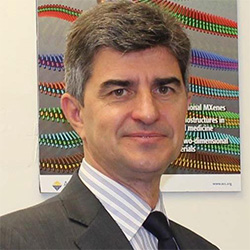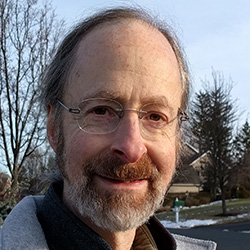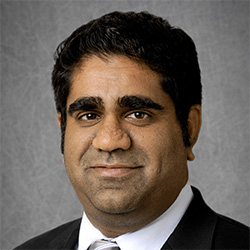
When:
Tuesday, January 10, 2017
4:00 PM - 5:00 PM CT
Where: Technological Institute, Tech L211, 2145 Sheridan Road, Evanston, IL 60208 map it
Contact:
Department Office
(847) 491-3537
Group: Department of Materials Science and Engineering (MatSci)
Category: Lectures & Meetings
Description:
By: Josh Robinson
Abstract: The last decade has seen nearly exponential growth in the science and technology of two-dimensional materials. Beyond graphene, there is a huge variety of layered materials that range in properties from insulating to superconducting. Furthermore, heterogeneous stacking of 2D materials also allows for additional “dimensionality” for band structure engineering. In this talk, I will discuss recent breakthroughs in two-dimensional atomic layer synthesis and properties, including novel 2D heterostructures and novel 2D nitrides. Our recent works include development of an understanding of substrate impact on 2D layer growth and how we can tune the substrate to acheive near-single crystal 2D materials over large areas. I will also dsicuss doping of 2D materials with magentic elements, selective area synthesis of 2D materials, and the first demonstration of 2D gallium nitride (2D-GaN). Our work and the work of our collaborators has lead to a better understanding of how substrate not only impacts 2D crystal quality, but also doping efficiency in 2D materials, and stabalization of nitrides at their quantum limit.
Bio: Dr. Robinson obtained his B.S. degree in Physics with minors in Chemistry and Mathematics from Towson University in 2001. He received his doctorate degree from The Pennsylvania State University in Materials Science and Engineering in 2005. In 2012, he joined the Penn State Materials Science and Engineering Department as an Assistant Professor. In 2013, he co-founded the Center for Two-Dimensional and Layered Materials, and currently serves as Associate Director of the Center. In July 2015, he became Co-Director of the NSF I/UCRC Center for Atomically Thin Multifunctional Coatings (ATOMIC), and most recently, in 2016, he became the Director of User Programs for the NSF-funded 2D Crystal Consortium. He has authored or co-authored over 100 peer reviewed journal publications with a significant focus on low dimensional electronic materials. He has patents on chemical and neutron detection, and various pending patents related to 2D materials.
Understanding Nanoconfinement and Nanoscale Interfaces in Polymer Nanocomposites

When:
Tuesday, January 17, 2017
4:00 PM - 5:00 PM CT
Where: Technological Institute, Tech L211, 2145 Sheridan Road, Evanston, IL 60208 map it
Contact:
Department Office
(847) 491-3537
Group: Department of Materials Science and Engineering (MatSci)
Category: Lectures & Meetings
Description:
Understanding Nanoconfinement and Nanoscale Interfaces in Polymer Nanocomposites
By: Sinan Keten
Abstract: Natural and engineered structural (load-bearing) polymer nanocomposites often try to exploit microphases that are confined in nanoscale dimensions to achieve remarkable mechanical properties. However, the dynamic properties of these materials depend strongly on both the chemistry of the interfaces and the microstructure of the material system, which complicates their design. In this talk, a new computational materials-by-design approach based on coarse-grained molecular simulations for understanding physical phenomena occurring at such disparate scales. I will discuss several cases where the coupling between nanostructure and chemical structure will lead to intriguing features, such as polymers with similar bulk properties exhibiting contrasting glass-formation behavior under nanoconfinement in thin films. Drawing an analogy between thin films and nanocomposites, I will illustrate how understanding thin film simulations help us design better load-bearing nanocomposites with multi-layer graphene and nanocellulose fillers. I will conclude with an outlook on impact tolerant polymer nanocomposites and tough interfaces inspired from biological systems.
Bio: Sinan Keten is an Associate Professor of Civil & Environmental Engineering and Mechanical Engineering at Northwestern University. He joined Northwestern University faculty in 2010 after obtaining his Ph.D. from MIT. His research expertise is on computational materials science and mechanics with an emphasis on polymer nanocomposites and biomolecular materials. He has 73 publications in reputable interdisciplinary journals including Nature Materials, Nature Communications, ACS Nano and Nano Letters. He has received the Office of Naval Research (ONR) Young Investigator Program (YIP) Award in 2015 and ONR Director of Research Early Career Award in 2016. He became a Fellow of the American Physical Society in 2016 and has received other recognitions from the American Society of Mechanical Engineers (ASME) and the Materials Research Society (MRS).

When:
Tuesday, January 24, 2017
4:00 PM - 5:00 PM CT
Where: Technological Institute, Tech L211, 2145 Sheridan Road, Evanston, IL 60208 map it
Contact:
Department Office
(847) 491-3537
Group: Department of Materials Science and Engineering (MatSci)
Category: Lectures & Meetings
Description:
Two - Dimensional Carbides and Nitrides Expand the Flatlands
By: Yury Gogotsi
Abstract: Two-dimensional (2D) solids – the thinnest materials available to us – offer unique properties and a potential path to device miniaturization. The most famous example is graphene, which is an atomically thin layer of carbon atoms bonded together in-plane with sp2 bonds. In 2011, a new family of 2D solids – transition metal carbides and nitrides (Ti2C, Ti3C2, Nb4C3, Ti4N3, etc.) – was discovered by Drexel University scientists [1]. These 2D solids with a composition Mn+1Xn (M is a transition metal, X is C or N) were labeled “MXenes”. More than 20 different carbides, nitrides and carbonitrides have been reported to date [2-5]. A new sub-family of multi-element ordered MXenes was discovered recently [2]. Structure and properties of numerous MXenes have been predicted by the density functional theory, showing that MXenes can be metallic or semiconducting, depending on their composition and surface termination. Their elastic constants along the basal plane are expected to be higher than that of the binary carbides. Oxygen or OH terminated MXenes are hydrophilic, but electrically conductive. Hydrazine, urea and other polar organic molecules can intercalate MXenes leading to an increase of their c lattice parameter [3]. One of the many potential applications for 2D Ti3C2 is in electrical energy storage devices such as batteries, Li-ion capacitors and supercapacitors [3-5]. Metallic MXenes have a potential for use in electromagnetic interference (EMI) shielding, transparent conducting coatings and many other applications. The reported EMI shielding efficiency values of flexible Ti3C2Tx films are the highest of any known synthetic materials with similar thickness [6]. Moreover, excellent shielding ability is maintained after adding sodium alginate to create polymer composite films. The 2D structure, combined with high conductivity and good electronic coupling between the layers, is responsible for the extremely high EMI shielding efficiency of MXenes [6].
1. M. Naguib, et al, Advanced Materials, 23 (37), 4207-4331 (2011)
2. B. Anasori, et al, ACS Nano, 9 (10) 9507–9516 (2015)
3. O. Mashtalir, et al, Nature Communication, 4, 1716 (2013)
4. M M. Ghidiu, Nature, 516, 78–81 (2014)
5. M. Naguib, Y. Gogotsi, Accounts of Chemical Research, 48, 128-135 (2015)
6. F. Shahzad, et al, Science 353, 1137-1140 (2016)
Bio: Yury Gogotsi is Distinguished University Professor and Trustee Chair of Materials Science and Engineering at Drexel University. He is the founding Director of the A.J. Drexel Nanomaterials Institute and Associate Editor of ACS Nano. He works on nanostructured carbons and two-dimensional carbides for energy related and biomedical applications. His work on selective extraction synthesis of carbon and carbide nanomaterials with tunable structure and porosity had a strong impact on the field of capacitive energy storage. He has co-authored 2 books, more than 450 journal papers and obtained more than 50 patents. He has received numerous national and international awards for his research. He was recognized as Highly Cited Researcher by Thomson-Reuters in 2014-2016, and elected a Fellow of AAAS, MRS, ECS, RSC, ACerS and the World Academy of Ceramics.
MSE Dorn Lecture: Morphology and Crystal Phase Selection in Nanowire Growth

When:
Tuesday, January 31, 2017
4:00 PM - 5:00 PM CT
Where: Technological Institute, Tech L211, 2145 Sheridan Road, Evanston, IL 60208 map it
Contact:
Department Office
(847) 491-3537
Group: Department of Materials Science and Engineering (MatSci)
Category: Lectures & Meetings
Description:
Morphology and Crystal Phase Selection in Nanowire Growth
By: Jerry Tersoff
Abstract: Nanowires of GaAs and other III-V semiconductors are routinely grown from liquid catalyst droplets. Remarkably, the growth can be switched between zincblende and wurtzite crystal structure, simply by changing the gas pressure. These systems provide an ideal laboratory for studying the controlled formation of non-equilibrium crystal structures, which is one of the most important challenges in crystal growth. Controlled phase switching also enables novel nanowire device structures. Recent observations using in-situ transmission electron microscopy, together with theory, reveal how the phase is controlled in nanowire growth. The surprising explanation hinges on a small detail of the wire shape that wasn't even noticed until a few years ago. The story begins with earlier work showing how the growing wire is shaped by capillary forces from the catalyst droplet, and ends with untangling the mechanism of crystal phase selection.
Bio: Jerry Tersoff is a Principal Research Staff member at the IBM Thomas J. Watson Research Center. He has worked in diverse areas relating to the theory of surfaces, interfaces, materials physics, and device physics. His recent research includes semiconductor nanowire growth; nanoscale effects in heteroepitaxy, including stress-driven formation of quantum dots; and the physics of carbon nanotube devices. His early work includes theories of scanning tunneling microscopy, Schottky barriers, and heterojunction band lineups. He also developed model interatomic potentials that are widely used in materials simulations. His work has been recognized by the Davisson-Germer Prize of the American Physical Society, the Medard Welch Award of the American Vacuum Society, and the MRS Medal. He is a Fellow of the APS, AVS, and MRS. He is first author of 8 papers cited over 1000 times, and has an h-index of 81. He received his B.A. in Physics from Swarthmore College, and his Ph.D. in Physics from the University of California, Berkeley.
Fighting Entropy: Strategies for Retention of Nanostructured Material Performance

When:
Tuesday, February 7, 2017
4:00 PM - 5:00 PM CT
Where: Technological Institute, Tech L211, 2145 Sheridan Road, Evanston, IL 60208 map it
Contact:
Department Office
(847) 491-3537
Group: Department of Materials Science and Engineering (MatSci)
Category: Lectures & Meetings
Description:
Fighting Entropy: Strategies for Retention of Nanostructured Material Performance
By: Suveen Mathaudhu
Abstract: Nanostructured and nanocomposite materials have garnered tremendous interest over the past two decades due to their impressive increases in physical and functional properties over their course-grained counterparts. Laboratory-scale properties have forecast revolutionary performance in a wide breath of technological applications, however advancement has largely been limited by the relative instability of the nanostructured features and phases at the elevated temperatures and pressures needed for manufacturing and fabrication. In this lecture, strategies that incorporate new predictive theoretical and computational approaches, advanced processing and characterization tools for “top-down” and “bottom-up” processing of ultrahigh strength nanostructured/nanocomposite Cu and Mg-alloys will be presented. From these cases, we will target and distill some key emerging areas of scientific and technological opportunity for overcoming the daunting challenges that thermodynamic equilibrium presents us with, and that will enable the creation of bulk engineered structural materials with stable, tailored nanostructured features.
Bio: Suveen Mathaudhu serves as an Assistant Professor in the Mechanical Engineering Department and Materials Science and Engineering Program at UC Riverside, where he studies the underpinning mechanisms that will make metallic materials and composites lighter and stronger. He concurrently has a joint appointment as Chief Scientist at the Pacific Northwest National Laboratory in the Energy and Environment Directorate. He received his Ph.D. in Mechanical Engineering from Texas A&M University in 2006. There, he studied processing methods to produce bulk nanocrystalline and metastable metals for structural and defense applications. He subsequently served as an ORISE post-doctoral Fellow and then a Staff Scientist at the U.S. Army Research Laboratory from 2006-2010. From 2010 - 2014, he was the Program Manager for the Synthesis and Processing of Materials at the U.S. Army Research Office, and also, an Adjunct Assistant Professor in the Materials Science and Engineering Department at North Carolina State University. He is active in several technical societies, and frequently speaks and writes on science of superheroes as a broad STEM outreach tool.